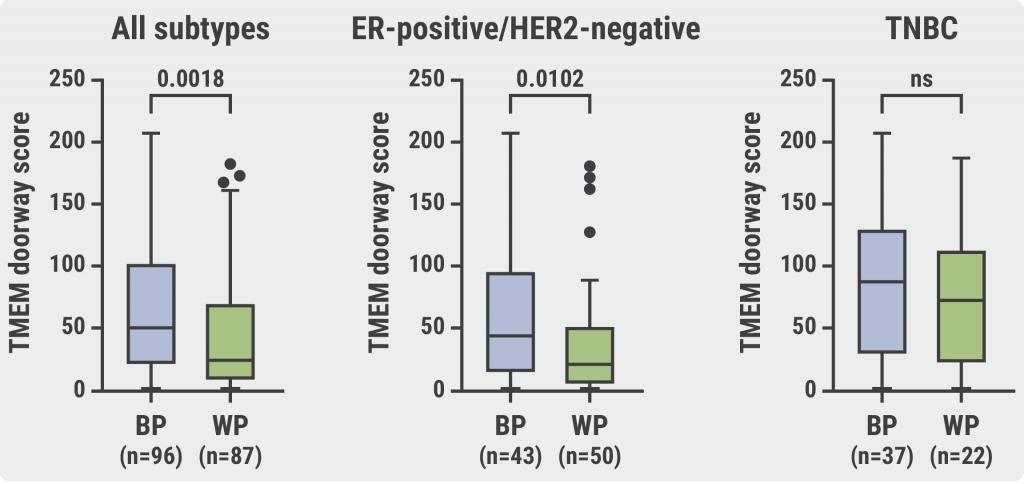https://doi.org/10.55788/53c2cea1
Black patients with breast cancer have 40% higher death rates compared with White patients [1]. In line with this, Black race is associated with a higher risk of distant recurrence rate and a poorer survival in ER-positive/HER2-negative, but not in triple-negative breast cancer (TNBC) patients with residual disease after neoadjuvant chemotherapy [2].
Previous research showed that neoadjuvant chemotherapy can induce breast cancer metastasis by opening tumour microenvironment of metastasis (TMEM) doorways [3]. These TMEM doorways consist of three-cell structures in primary breast tumours in which an invasive tumour cell, partially inserted into a blood vessel wall, is bound to an endothelial cell and a macrophage. TMEM doorway density proves to be a prognostic marker for metastasis in breast cancer patients, especially in ER-positive/HER2-negative disease [4]. To evaluate the role of TMEM doorway density in the racial disparity in breast cancer outcomes, a retrospective study was done. Dr Burcu Karadal-Ferrena (Albert Einstein College of Medicine, NY, USA) presented the results [5].
The study included 183 patients (96 self-identified as Black, 87 as White) with HER2-negative disease and with residual disease ≥5 mm after neoadjuvant chemotherapy. Black patients had higher grade disease (76% vs 65% grade 3), higher rate of distant recurrence (49% vs 42%), and were more likely to undergo mastectomy (70% vs 62%), compared with White patients. Automated quantification of TMEM doorway density showed higher scores in ER-positive/HER2-negative Black patients compared with White patients (P=0.0102), but not in TNBC Black versus White patients (see Figure). In addition, a high TMEM doorway score was associated with worse disease recurrence-free survival in all ER-positive/HER2-negative patients, but not in TNBC patients.
Figure: TMEM doorway score higher in Black patients in the entire cohort and in the ER-positive/HER2-negative subtype [5]

TMEM, tumour microenvironment of metastasis; BP, Black patients; WP, White patients; TNBC, triple-negative breast cancer; ns, non-significant.
Based on these results, Dr Karadal-Ferrena concluded: “A high TMEM doorway score is an independent prognostic risk factor in patients with residual disease after neoadjuvant chemotherapy. Racial disparity in breast cancer outcomes may be due to a more pronounced increase in TMEM doorway density after neoadjuvant chemotherapy in Black patients.” A limitation of the study, Dr Karadal-Ferrena said, was that neither TMEM doorway density at baseline nor the change in TMEM doorway score after neoadjuvant chemotherapy were evaluated.
- DeSantis CE, et al. CA Cancer J Clin. 2019;69:438–451.
- Kim G, et al. Cancer. 2022;128:2728–2735.
- Karagiannis GS, et al. Sci Transl Med. 2017;9(397):eaan0026.
- Sparano JA, et al. NPJ Breast Cancer. 2017;3:47.
- Karadal-Ferrena B, et al. Racial disparity in tumour microenvironmental and outcomes in residual breast cancer treated with neoadjuvant chemotherapy. Abstract GS1-02, SABCS 2022, 6–10 December, San Antonio, TX, USA.
Copyright ©2023 Medicom Medical Publishers
Posted on
Previous Article
« Chemo-endocrine therapy worse for cognition than endocrine therapy alone Next Article
Letter from the Editor »
« Chemo-endocrine therapy worse for cognition than endocrine therapy alone Next Article
Letter from the Editor »
Table of Contents: SABCS 2022
Featured articles
Miscellaneous
Racial disparity in the tumour microenvironment
Chemo-endocrine therapy worse for cognition than endocrine therapy alone
Early-Stage Breast Cancer
Anti-PD-1/anti-LAG-3 combination highly effective in HER2-negative breast cancer
MammaPrint test predictive for benefit of extended endocrine therapy
HR-positive/HER2-positive Breast Cancer: Trastuzumab-Deruxtecan
Trastuzumab deruxtecan effective in both second-line and neoadjuvant setting
HR-positive/HER2-negative Advanced Metastatic Breast Cancer
Benefit of adjuvant abemaciclib continues to deepen at longer follow-up
First-line ribociclib plus endocrine therapy outperforms combination chemotherapy
Treatment options beyond CDK4/6 inhibition
Triple-Negative Breast Cancer
Baseline CTC count can guide first-line treatment in HR-positive/HER-negative metastatic breast cancer
ZNF689 deficiency promotes intratumour heterogeneity and resistance to immune checkpoint blockade in TNBC
Oestradiol represses anti-tumoural immune response to promote progression of brain metastases
Basic and Translational Research
Resistance to CDK4/6 inhibitors is likely due to expansion of pre-existing resistant clones
Germline pathogenic variants for breast cancer also increase contralateral breast cancer risk
Low-dose tamoxifen still prevents recurrence from non-invasive breast cancer
Endocrine interruption to pursue pregnancy does not impact short-term disease in breast cancer
Related Articles
September 21, 2021
Lung Cancer Europe patient survey identifies gaps in lung cancer care

January 31, 2022
Letter from the Editor
© 2024 Medicom Medical Publishers. All rights reserved. Terms and Conditions | Privacy Policy

